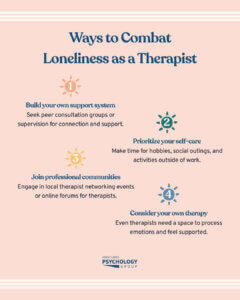Being a therapist means sitting with others through their most vulnerable moments, holding space for emotion, and offering steady presence in times of distress. It’s deeply meaningful work, but it can also be surprisingly isolating.
Even while surrounded by people all day, clinicians may find themselves feeling lonely. This isn’t a personal failing. When your focus is on someone else’s pain, growth, or healing, there can, at times, be minimal room left to check in with your own.
Here’s why that loneliness can show up and what might help.
The Quiet Weight of Working Alone
In many professions, colleagues casually connect throughout the day, sharing stories, offering support, or simply chatting about life outside of work. These moments of connection can go a long way in creating a sense of community.
But for therapists, especially those in private practice or providing virtual care, that kind of day-to-day interaction is often missing. Much of the work is done in isolation, with little opportunity for casual conversation or spontaneous connection with peers.
Over time, the absence of these small touchpoints can create a sense of disconnection. Even after a full day of meaningful sessions, you might find yourself feeling emotionally distant or alone. Without regular connection to colleagues who understand the unique weight of the work, it’s easy to feel like you’re carrying it all on your own.
The Pressure to Have It Together
There’s often an unspoken expectation that therapists should be emotionally grounded, resilient, and immune to the struggles they help others navigate. This pressure can make it harder to admit when you’re feeling disconnected or depleted.
You might find yourself thinking:
- “If I feel this way, what does that say about me as a therapist?”
- “I don’t want to burden anyone with what I’m feeling.”
- “Other therapists probably aren’t struggling like this.”
But the truth is, therapists are human and loneliness, like any other emotion, is something that deserves your attention.
Signs You Might Be Feeling Lonely
Loneliness can be subtle and easy to overlook. It may show up as:
- A vague sense of disconnection or emptiness after sessions
- Feeling distant from friends or loved ones
- Craving conversation but avoiding it
- Fatigue that feels emotional rather than physical
- A desire for more meaningful interaction beyond your clinical role
Recognizing the feeling is the first step toward tending to it.
Ways to Reconnect
Seek out clinical community
Being in regular connection with other therapists can be grounding. Peer consultation, supervision, or even informal check-ins can help you feel less alone in the work. At Great Lakes Psychology Group, our network of clinicians is one of our greatest strengths. Opportunities for consultation and connection are built into our model, so you’re never navigating challenges in isolation.
Invest in non-clinical relationships
Make space for relationships where you’re not in the role of helper. Spend time with people who know you outside of your professional identity. These connections offer grounding, laughter, and the chance to be seen in a different way.
Set boundaries that protect your energy
Loneliness can be made worse by burnout. Build in breaks, limit your caseload when needed, and make time for activities that refill your cup. When your energy is protected, it’s easier to engage meaningfully with others.
Name it when it shows up
You don’t have to carry loneliness quietly. Whether it’s with a colleague, a supervisor, or a trusted friend, naming what you’re feeling creates room for connection. You deserve support just as much as the clients you serve.
Final Thought
Loneliness as a therapist doesn’t mean you’re doing anything wrong. It’s often a natural byproduct of the emotional weight you carry and the structure of the work itself. But connection is still possible and necessary.
You’re not alone in feeling this way, and you don’t have to go at it alone moving forward. Small steps toward connection, such as honest conversations, intentional time with people who see you, and care that goes both ways, can make a big difference.


 Thriving as a Clinician Through Fall and Winter
Thriving as a Clinician Through Fall and Winter Cultivating a Growth Mindset as a Therapist
Cultivating a Growth Mindset as a Therapist Being a Therapist Without Being Everyone’s Therapist
Being a Therapist Without Being Everyone’s Therapist